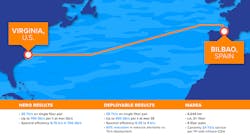Infinera, Facebook achieve 700-Gbps per wavelength transmission on MAREA submarine cable
In a blog posted today, Infinera (NASDAQ:INFN) reports on a high-speed transmission trial of its ICE6 coherent engine on Facebook’s MAREA transatlantic submarine cable. In a “hero experiment” scenario, a production version of an ICE6 module enabled wavelength transmission of 700 Gbps over 6,640 km. Under conditions designed to better mirror actual deployment conditions, the ICE6 still achieved a per-wavelength transmission rate of 650 Gbps. Both results are records for transmission across an undersea cable, Infinera asserts.
The 650-Gbps represents a total system capacity of 28 Tbps, according to Infinera Director of Solutions Marketing Geoff Bennett (who authored the blog) and Senior Vice President of Marketing Robert Shore. That capacity is fully in the C-Band, Bennett pointed out; C+L-band deployments are best suited to transpacific routes due to a combination of factors involving system length and the number of amplifiers required. The achievement was aided by the fact that MAREA uses cutting-edge large-area, low-loss optical fiber type based on a pure silica core. A short amplifier spacing of 56 km helps boosts optical signal-to-noise ratio as well.
In the blog, Dr. Steve Grubb, global network optical architect at Facebook, praised the results of the demonstration, noting that MAREA’s current capacity is a bit more than 24 Tbps (see "Microsoft, Facebook partner for MAREA undersea cable system"). “The great thing about ICE6 is that…the higher data rate per wave, the better the cost per bit – and that includes the fact that we need fewer transponders that consume less rack space and less electrical power,” Grubb is quoted as saying. “The 28-Tbps option with ICE6 reduces the network element count by 60% vs. the boxes previously required for 24 Tbps...That’s a huge improvement, especially in cable landing stations where real estate and power are often at a premium.”
Bennett and Shore hesitated to speculate whether Facebook will deploy ICE6 on MAREA, which still has unlit fiber. However, the performance improvements uncovered in the demonstration are “too much to ignore,” Shore stated.
With the ICE6 finally in production, Shore noted that Infinera’s engineers have improved the performance of the coherent engine since its initial demonstrations (see, for example, “Infinera sends 800G over 950 km in live network, touts increased appeal of 800G” from March 2020). He estimates that Infinera has enhanced the ICE6’s capabilities by 50% to 60% during that time.
Shore and Bennett said that the company’s current quiet period ahead of releasing its most recent quarterly results precluded them from saying whether ICE6 modules are not only in production but shipping. Meanwhile, word of further trials on undersea networks may be forthcoming. The two Infinera sources referenced a completed trial in the Pacific that Infinera is seeking permission to disclose publicly. The company also would like to test ICE6 on a submarine network architected with space-division multiplexing (SDM). They mentioned Dunant as a potential target for such an exercise (see "Google, SubCom, to deploy space-division multiplexing on Dunant submarine cable").
For related articles, visit the Network Design Topic Center.
For more information on high-speed transmission systems and suppliers, visit the Lightwave Buyer’s Guide.
To stay abreast of communications technology, subscribe to Lightwave’s Enabling Technologies Newsletter.
About the Author

Stephen Hardy
Editorial Director and Associate Publisher, Lightwave
Stephen Hardy is editorial director and associate publisher of Lightwave and Broadband Technology Report, part of the Lighting & Technology Group at Endeavor Business Media. Stephen is responsible for establishing and executing editorial strategy across the both brands’ websites, email newsletters, events, and other information products. He has covered the fiber-optics space for more than 20 years, and communications and technology for more than 35 years. During his tenure, Lightwave has received awards from Folio: and the American Society of Business Press Editors (ASBPE) for editorial excellence. Prior to joining Lightwave in 1997, Stephen worked for Telecommunications magazine and the Journal of Electronic Defense.
Stephen has moderated panels at numerous events, including the Optica Executive Forum, ECOC, and SCTE Cable-Tec Expo. He also is program director for the Lightwave Innovation Reviews and the Diamond Technology Reviews.
He has written numerous articles in all aspects of optical communications and fiber-optic networks, including fiber to the home (FTTH), PON, optical components, DWDM, fiber cables, packet optical transport, optical transceivers, lasers, fiber optic testing, and more.
You can connect with Stephen on LinkedIn as well as Twitter.
